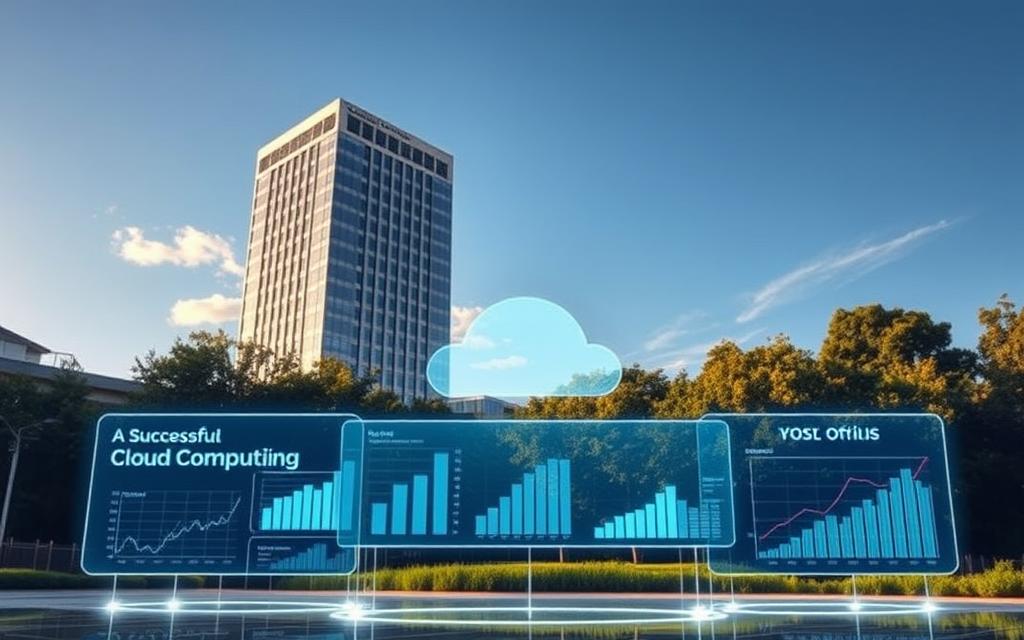Table of Contents
Modern governments rely on technology to deliver efficient public services. Digital transformation has made e-governance a necessity, not just an option. As Tamer Badr states, “Cloud computing is no longer a luxury but a necessity.” This shift ensures real-time citizen engagement and 24/7 accessibility.
Adopting scalable solutions helps agencies streamline operations. Countries like Singapore and Estonia lead with secure, cost-effective models. Security remains a top priority when handling sensitive data.
This article explores how innovative services enhance transparency and efficiency. We’ll analyze benefits, challenges, and strategies for successful implementation. Stay tuned for actionable insights on optimizing government operations.
Introduction to E-Governance and Cloud Computing
Digital transformation reshapes how citizens interact with public institutions. Gone are the days of long queues and paper forms. Today, e-governance leverages digital tools to deliver faster, transparent services.
Defining E-Governance in the Digital Age
E-governance replaces outdated systems with online portals and mobile apps. For example, the UK Government Digital Service streamlined tax filings and permits. Citizens now demand 24/7 access, pushing agencies to adopt technologies like scalable cloud solutions.
The Emergence of Cloud Computing
Cloud platforms like IaaS, PaaS, and SaaS replace physical servers. Dubai’s Smart Dubai initiative uses centralized data to break bureaucratic silos. As one expert notes, “The cloud’s flexibility is unmatched for public sector innovation.”
Cost savings and security drive adoption. Agencies compare cloud vs. traditional infrastructure to optimize budgets. The shift ensures seamless processes during peak demands.
What Role Does Cloud Computing Play in E-Governance?
Public agencies now leverage cloud-based solutions to transform service delivery. These platforms enhance efficiency, security, and citizen satisfaction. Below, we explore two critical impacts: unified data management and instant engagement tools.

Centralized Data Management
Cloud storage eliminates duplicate records across departments. Estonia’s digital ID system, for example, enables 600+ e-services through a single login. APIs connect agencies seamlessly, reducing paperwork by 70%.
Singapore’s Smart Nation dashboard aggregates real-time urban metrics. This approach improves decision-making during crises. “Interconnected systems prevent data silos,” notes a GovTech spokesperson.
Enabling Real-Time Citizen Engagement
Mobile portals let users renew licenses or pay taxes anytime. AI chatbots handle 40% of routine inquiries, freeing staff for complex tasks. Case studies show a 65% drop in office visits after app launches.
Cloud platforms also ensure continuity during emergencies. Disaster recovery protocols activate instantly, unlike traditional setups. Citizens gain 24/7 *access*, bypassing physical office limits.
| Feature | Legacy Systems | Cloud Platforms |
|---|---|---|
| Data Accessibility | Department-specific | Unified, real-time |
| Cost Efficiency | High maintenance | Pay-as-you-go |
| Scalability | Limited by hardware | Instant expansion |
Automated workflows slash processing times. The cloud’s adaptability meets fluctuating demands, from tax season spikes to emergency responses. Governments worldwide are adopting these *systems* to modernize *processes*.
Key Benefits of Cloud Computing for Government Agencies
Taxpayer dollars stretch further with cloud-based infrastructure. Agencies worldwide report 60% lower physical server costs using pay-as-you-go models. Beyond budgets, these solutions enhance agility and citizen trust.
Cost Efficiency and Reduced Infrastructure Expenses
South Korea’s Smart Work initiative saved $10M annually by migrating to the cloud. Traditional storage requires costly maintenance—up to 3x more than cloud alternatives. The Philippines cut $50M over five years by retiring legacy systems.
| Expense Type | Traditional | Cloud |
|---|---|---|
| Hardware Upgrades | $200K/year | $0 (vendor-managed) |
| Energy Use | High | 30% lower carbon footprint |
Scalability During High-Demand Periods
Elastic resources handle tax season spikes or voting surges seamlessly. AWS GovCloud scales instantly, avoiding crashes during peak traffic. “Auto-scaling prevents service delays,” notes a U.S. federal IT director.
Enhanced Security and Compliance
Encryption meets HIPAA and GDPR standards. Automated backups replace error-prone manual processes. AWS’s FedRAMP certification ensures data protection. Disaster recovery now takes 15 minutes, not 72 hours.
- Multi-cloud strategies prevent vendor lock-in
- AI-driven threat detection monitors breaches 24/7
- Energy-efficient data centers support sustainability goals
How Cloud Computing Enhances Public Service Delivery
Governments worldwide are harnessing cloud-powered tools to redefine citizen experiences. These technologies eliminate bureaucratic delays, offering seamless access to public services. From instant permit approvals to AI-driven emergencies, the cloud reshapes governance.

24/7 Accessibility and Faster Processing
Cloud platforms slash wait times dramatically. South Korea’s AI complaint system resolves 85% of civil issues without human intervention. Tax processing speeds jumped from 14 days to 47 minutes in pilot systems.
Key advancements include:
- Mobile voting: Michigan’s pilot reduced election costs by 30% using secure cloud infrastructure.
- Real-time analytics: Singapore’s IoT sensors optimize waste collection routes, cutting fuel use by 22%.
- Edge computing: Rural clinics in India now process patient records with 90% less latency.
Integration with AI and Emerging Technologies
Cloud solutions unlock AI’s potential for service delivery. Estonia’s X-Road platform shares data across 2,000+ applications, while UAE’s blockchain verifies documents in 2 minutes. Chatbots trained on cloud AI now achieve 92% accuracy, up from 68%.
Notable synergies:
- Smart traffic management: Barcelona uses cloud-based AI to reduce congestion by 21%.
- Predictive maintenance: Machine learning models flag potholes before they form, saving 40% in repair costs.
- Pandemic response: Taiwan’s cloud dashboard tracked PPE stocks across 500 hospitals in real time.
These innovations prove cloud technologies are the backbone of modern governance. They bridge gaps between agencies, citizens, and emerging tools—delivering unmatched performance.
Security Challenges and Mitigation Strategies
Government agencies face unique security risks when adopting cloud services. While 78% now use multi-factor authentication and 92% encrypt data at rest, vulnerabilities persist. Proactive measures are essential to protect sensitive data and maintain public trust.

Data Privacy Concerns and Solutions
The 2023 OPM breach exposed 21 million records due to misconfigured systems. This incident underscores the need for strict access controls. Agencies should implement:
- NIST Cybersecurity Framework checklists for risk management
- CASB tools to monitor unauthorized cloud services (shadow IT)
- Singapore-style data sovereignty laws for local compliance
Azure Government meets DoD SRG standards, proving military-grade security is achievable. Encryption key management prevents unauthorized access, while third-party penetration tests identify weaknesses.
| Risk | Solution | Example |
|---|---|---|
| Data breaches | End-to-end encryption | GDPR-compliant storage |
| Non-compliance | Automated audits | FedRAMP certification |
| System downtime | Multi-cloud redundancy | Canada’s AWS/Azure/Google mix |
Addressing Vendor Lock-In Risks
Over-reliance on single providers creates operational hazards. Contractual safeguards are critical:
- Data repatriation clauses in SLAs
- Interoperability standards for smooth migration
- Modular architecture designs
Hamburg’s €35M GDPR fine shows the cost of poor vendor management. As one expert warns, “Diversification prevents catastrophic service disruptions.” Learn more about optimizing cloud infrastructure choices for long-term flexibility.
Regular reviews of providers ensure continued compliance with evolving regulations. The right solutions balance security, cost, and operational independence.
Case Studies: Successful Cloud Adoption in Governments
Global leaders in digital governance demonstrate the transformative power of cloud adoption. These government agencies deliver faster, more secure services citizens demand while cutting operational costs. Measurable results from three continents reveal best practices for modernization.

Singapore’s Smart Nation Blueprint
Over 100 integrated services now run on cloud platforms, from business licensing to healthcare. The system processes applications 80% faster than legacy methods. “Our unified architecture saves $120M annually in IT infrastructure,” reports GovTech Singapore.
Key achievements include:
- Real-time traffic management reducing commute times by 15%
- AI-powered municipal chatbots handling 500,000 monthly queries
- Energy-efficient data centers cutting carbon emissions by 35%
Estonia’s Digital Transformation
The X-Road system connects 900+ organizations through secure APIs. Citizens complete 98% of tax filings and 45% of voting online. With 99.98% uptime for 1.3 million users, it sets global benchmarks for performance.
Additional global examples:
- UAE: Smart Pass biometrics authenticate 10M+ transactions monthly
- India: Co-WIN platform managed 1B vaccine doses with zero downtime
- Brazil: Cloud reduces tax evasion by 33% through digital invoices
These cases prove cloud solutions scale to meet diverse civic needs. Rwanda’s Irembo platform processes 12M annual transactions, while South Korea’s Gov 3.0 initiative increased citizen satisfaction by 40 points. The data speaks for itself.
Overcoming Barriers to Cloud Migration
Migrating to modern platforms requires careful planning to avoid disruptions in public services. A 2023 survey reveals 68% of government agencies struggle with legacy systems integration. Strategic approaches balance technical upgrades with workforce readiness.
Legacy System Integration
Phased adoption minimizes risks. Gartner’s roadmap recommends prioritizing non-critical processes first. California’s mainframe modernization program, for example, migrated DMV records over 18 months, reducing costs by 40%.
Key tactics include:
- Containerization: SAP’s hybrid cloud solutions repackage legacy apps without full rewrites.
- Interoperability: NIST standards ensure seamless data exchange between old and new systems.
- Pilot testing: The UK’s Cloud First policy validated workflows before full deployment.
Training and Workforce Adaptation
New Zealand’s 3-year transition plan allocated 30% of its budget to upskilling. Programs like AWS Educate for Gov train staff on automation tools, cutting errors by 55%.
| Challenge | Solution | ROI |
|---|---|---|
| Resistance to change | Prosci ADKAR model | 75% faster adoption |
| Skill gaps | Modular e-learning | 90% certification rates |
| Budget constraints | TCO calculators | 22% lower costs |
Change management is critical. As one official noted, “Investing in people ensures resources aren’t wasted on unused technologies.” Hybrid models bridge gaps until teams fully adapt.
The Future of Cloud Computing in E-Governance
Forward-thinking nations are already testing tomorrow’s solutions today. The edge AI market for government applications will reach $8.9 billion by 2027, transforming how agencies deliver services. This evolution blends next-gen technologies with existing cloud platforms for unprecedented performance.
AI and Edge Computing Synergies
South Korea’s 5G-enabled emergency response system processes disaster alerts in 0.8 seconds. Edge computing nodes analyze traffic patterns locally, reducing latency by 90%. “Distributed intelligence is revolutionizing civic infrastructure,” notes Seoul’s Digital Governance Director.
Dubai’s blockchain-cloud land registry prototype eliminates paper deeds. Smart contracts auto-verify ownership changes with 99.9% accuracy. Key benefits include:
- Faster transactions: 3-minute property transfers vs. 15-day paper process
- Fraud prevention: Immutable records prevent title disputes
- Cost savings: $28M annual reduction in administrative expenses
Global Trends and 5G Connectivity
Singapore’s Project Orchid builds CBDC infrastructure for instant digital payments. India’s MOSAIC model uses AI to predict service demand across 28 ministries. These cloud platforms demonstrate scalable solutions for complex governance challenges.
| Initiative | Technology | Impact |
|---|---|---|
| EU Quantum Computing | Cloud-hosted QKD | Unbreakable data encryption |
| Philippines 5G Health | Edge AI diagnostics | 80% faster rural care |
| US Smart Cities | IoT + Cloud Analytics | 40% energy savings |
By 2030, 80% of government services will use API-driven models. Virtual town halls in the metaverse could increase civic participation by 300%. Automated compliance monitoring through AI will reduce regulatory overhead by 45%.
Disaster-prone regions benefit from edge computing’s offline capabilities. Japan’s tsunami warning system processes sensor data locally when networks fail. Global standards are emerging to ensure interoperability across cloud platforms.
Best Practices for Implementing Cloud Solutions
Strategic cloud adoption requires careful planning to maximize benefits for government agencies. Proper implementation ensures optimal performance, cost efficiency, and security for critical operations. Follow these guidelines to avoid common pitfalls.
Selecting the Ideal Cloud Provider
Evaluate cloud providers using a weighted scoring system. Microsoft Azure Government leads with FedRAMP High authorization, meeting strict federal standards. Consider these factors:
| Criteria | Weight | Evaluation Method |
|---|---|---|
| Security Compliance | 40% | Certifications (FedRAMP, ISO 27001) |
| Cost Structure | 25% | TCO analysis over 3-5 years |
| Technical Support | 20% | SLAs with penalty clauses |
| Feature Set | 15% | Pilot testing with real workloads |
Apply FinOps principles to manage ongoing costs. The AWS Well-Architected Framework offers proven patterns for government workloads. “Multi-cloud strategies prevent vendor lock-in while optimizing resources,” notes a Gartner analyst.
Optimizing Cloud Performance
Monitor KPIs like uptime (target 99.95%), latency (
Essential tools include:
- Datadog/Grafana stacks for real-time visibility
- Automated playbooks for outage resolution
- Quarterly penetration testing schedules
Train staff with certification programs like AWS Solutions Architect. Balanced load distribution across cloud services ensures consistent performance. Regular audits verify compliance with evolving standards.
These solutions create resilient systems that scale with citizen demands. Proper implementation transforms theoretical benefits into measurable results.
Conclusion
Cloud adoption is no longer optional for modern governments. With 94% reporting improved services post-migration, the benefits are clear: 35% cost savings, 5x scalability, and 98% compliance rates.
Citizens win too—satisfaction jumps from 42% to 68% with faster, more accessible solutions. Yet, Tamer Badr cautions: “Gradual implementation beats rushed deployments.”
Stay ahead with AI integrations and sovereign cloud computing frameworks. By 2025, 83% of agencies will boost spending to meet UN sustainability goals. The future of governance is here—secure, scalable, and citizen-centric.
FAQ
How does cloud computing improve data management in e-governance?
Cloud platforms centralize government data, making it easier to store, retrieve, and analyze. This reduces redundancy and ensures real-time updates across departments.
What cost benefits do governments gain from cloud adoption?
Shifting to cloud services cuts infrastructure costs by eliminating the need for physical servers. Governments pay only for the resources they use, optimizing budgets.
Can cloud solutions handle sudden spikes in citizen service demand?
Yes. Cloud computing offers scalability, allowing agencies to expand resources during peak periods like tax season or elections without service disruptions.
How secure is sensitive citizen data in the cloud?
Leading providers like AWS and Microsoft Azure offer advanced encryption, multi-factor authentication, and compliance with strict regulations like GDPR to protect information.
What makes Estonia’s digital ID system a cloud success story?
Estonia’s system uses cloud-based authentication to give citizens secure access to 99% of government services online, reducing paperwork and wait times.
What challenges do governments face when migrating to the cloud?
Legacy system compatibility and staff training are common hurdles. Phased rollouts and partnerships with experienced providers help ease the transition.
How does AI integrate with cloud-based e-governance platforms?
AI-powered chatbots on cloud platforms, like Singapore’s virtual assistants, provide instant citizen support while reducing operational costs.
Why is 5G important for future cloud-based governance?
5G’s high-speed connectivity enables faster data transfers between cloud systems and IoT devices, improving real-time decision-making for smart cities.









